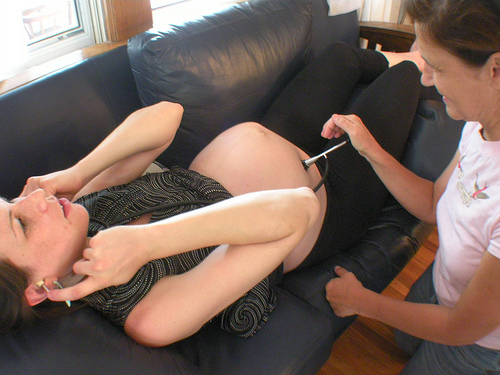May 02, 2013
MANA Response to Recent AAP Home Birth Statement: High-quality out-of-hospital newborn and postpartum care is standard for midwives
By: Sharon Muza, BS, LCCE, FACCE, CD/BDT(DONA), CLE | 0 Comments
By Geradine Simkins, CNM, MSN, Executive Director of Midwives Alliance of North America
This week, the American Academy of Pediatrics released a policy statement on home birth. While the statement affirmed "the right of women to make a medically informed decision about delivery", many advocates expressed concerns. The statement failed to recognize Certified Professional Midwives, the providers most likely to attend a home birth in the United States. In this response, the Midwives Alliance of North America helps families, providers, and policy makers understand the critical role CPMs play in safe, healthy birth options. - Sharon Muza, Community Manager, Science & Sensibility
High-quality out-of-hospital newborn and postpartum care is standard for midwives

© http://flic.kr/p/8d52Qc
The Midwives Alliance of North America welcomes the primary concept communicated in the American Academy of Pediatrics'April 24, 2013, policy statement entitled "Planned Home Birth." As should be expected, AAP reminds its practitioners that newborn infants-regardless of the setting in which they are born-deserve an equal and unbiased, high-quality standard of care. The Midwives Alliance joins with AAP in affirming the need for a collaborative and integrated maternity care system that addresses the needs of all mothers and infants, regardless of the provider type or birth setting a woman chooses.
We are disappointed, however, in AAP's decision to align with the American Congress of Obstetrics and Gynecologists' policy on home birth. Serving the needs of the growing number of families choosing to birth at home, Certified Professional Midwives attend the majority of intended home births in the U.S., when a skilled attendant is present, making them the primary care providers for newborns in the home setting.
Certified Professional Midwives are skilled maternity care providers
AAP's itemized recommendations for infant and newborn care, contained in their policy statement, are standard practice for credentialed midwives. In that respect, we find much with which we agree. These standard newborn exams, screens, and preventative care practices are wholly part of a credentialed midwife's scope of practice, and further endorsed by individual state health departments. We also note that as AAP Neonatal Resuscitation Program certificate holders (required for certification and recertification), credentialed midwives follow guidelines laid out in AAP's recommendations, and typically surpass those standard recommendations by having at least two NRP- and CPR-trained attendants at out-of-hospital births.
In fact, the AAP's guidelines for the care of infants intentionally born at home parallel those standards practiced by trained midwives in all birth settings. The practices listed-such as working medical equipment, emergency plans of transfer, thorough newborn exams, and so forth-are professional standards exhibited and documented by credentialed midwives, regardless of the place of birth.
The AAP policy statement, however, did not recognize or acknowledge Certified Professional Midwives (CPM), indicating that AAP may not have a thorough understanding of the training, skills, knowledge, and abilities of this country's primary maternity care provider for infants born out of the hospital. The Certified Professional Midwife is the only national midwifery credential that requirespractitionerstobetrained specifically to provide prenatal, intrapartum, and postnatal care in out-of-hospital settings. CPMs are knowledgeable, expert and independent midwifery practitioners who have met the standards for certification set by the North American Registry of Midwives (NARM). NARM is accredited by the National Commission for Certifying Agencies (NCCA) to issue the professional credential of Certified Professional Midwife, which is the same agency that accredits the American Midwifery Certification Board to issue the professional credentials of Certified-Nurse Midwife, and Certified Midwife.
Midwives are the providers of choice for out-of-hospital births, whether they occur at home or in freestanding birth centers. Offered since 1994, the CPM is currently the basis for licensure in 27 states while 11 additional states are actively seeking CPM licensure. In fact, one in nine newly certified midwives in the U.S. are Certified Professional Midwives.
The AAP policy statement endorses birth center maternity care, which is another area in which we are in agreement. Recent numbers from the American Association of Birth Centers (AABC) indicate that a significant proportion of accredited birth centers are owned and operated by Certified Professional Midwives. A January 2013 study, The National Birth Center Study II , conducted by AABC and published in the Journal of Midwifery & Women's Health, the official journal of the American College of Nurse-Midwives (ACNM), highlights the benefits for women who seek care at midwife-led birth centers. Findings also reinforce longstanding evidence that providers at midwife-led birth centers provide safe and effective health care for women during pregnancy, labor, birth, and the postpartum period.
Midwives provide high-quality care that meets both national and international guidelines
In highlighting the ethic of high-quality care for all infants across the spectrum-regardless of the site of birth-it should be noted that Certified Professional Midwives provide care intentionally similar to that of nurse-midwives and physicians. Yet we also know that CPMs are able to offer additional and valued care in terms of frequency of home visits and intense monitoring of newborns in their homes in the first weeks of life-a benefit not normally conferred to women and babies who have experienced hospital births.
This high-quality midwifery care includes routine newborn APGAR assessments, comprehensive head-to-toe physical examinations, measurements of length, head, abdomen and birth weight, monitoring vital signs including thermoregulation, assessment of respiratory sounds and patterns, assessments of cardiac sounds and peripheral pulses, assessment of gestational age and physical maturity, neuromuscular assessments, and assistance with initiation and ongoing assessment of breastfeeding. All findings are recorded in patient records and shared with mothers, per professional standards.
In addition, CPMs provide newborns with Vitamin K treatment, antibiotic eye ointment, umbilical cord care, metabolic newborn screening, glucose and bilirubin testing as indicated, and either perform Otoacoustic Emissions (OAE) hearing screens or refer to area audiologists. Midwives in a number of states are moving toward, or already offering, pulse-oximetry screening for Critical Congenital Heart Defects (CCHD) per AAP guidelines, in advance of many hospital systems. In the rare cases when newborns require consultation or referral, infants are transferred to the tertiary care system, and pediatricians where available, for active management.
Not only do Certified Professional Midwives and Certified Nurse-Midwives who attend home births provide the level of care outlined by the AAP, they provide it in a personalized, woman-centered, family-centered, culturally competent, and individualized manner that is qualitatively different from the customary assembly-line postpartum care commonly experienced in U.S. hospitals.
For example, in a home birth setting, the midwife typically conducts the initial newborn exam in the presence of the mother and family, which does not disrupt the crucial process of mother-infant bonding and breastfeeding, and is focused on being instructive to the family. Midwives provide holistic care to the mother-baby dyad in concordance with World Health Organization's Baby-Friendly best practices.
As a way of illustrating important differences in care practices, we can point to the recent Breastfeeding Report Card issued by the CDC (2012) that indicates only six percent of U.S. hospitals are offering care that aligns with the international best practices outlined by Healthy People 2020. By contrast in a 2005 study, 95% of babies born at home under the care of Certified Professional Midwives were exclusively breastfeeding at six weeks of age (Johnson & Daviss, 2005). This is just one area where midwives are well-trained, skilled, and uniquely positioned to help families succeed.
An opportunity for collaboration and integrated care
Physician conversations about home birth and midwife-led birth will be better informed and more useful to maternity care consumers if AAP is able to become more cognizant of important changes in the landscape of U.S. midwifery.
The release of the AAP policy statement on care of newborns born at home is an opportunity to reinforce the need for professional and seamless collaboration with members of community health care teams. We view this statement's release as an opportunity to align best practices for all parties who care for and support families choosing home birth.
The Midwives Alliance stands ready to work with other pediatric and maternity care providers to establish best practices in the postpartum period to not merely provide the basic level of care in the first hours, days and weeks of life for the newborn as outlined in the latest AAP statement, but to elevate that standard to include support for breastfeeding and the personal attention that can prevent infant death and improve maternal and child health. Babies born in all settings deserve this kind of care.
About Geradine Simkins
 Geradine Simkins, CNM, MSN is an activist, midwife and author. She began as a direct-entry home birth midwife in 1976 and became a nurse-midwife twenty years later. For over thirty years she has provided health care for women, infants and families in a variety of settings, including attendance at births in the home, a freestanding birth center, and hospitals. Geradine's work with migrant farmworkers and American Indian tribes focuses on addressing health care disparities and engendering a more equitable maternity care system for all women and infants. Geradine is currently the Executive Director of Midwives Alliance of North America, a professional organization that promotes excellence in midwifery and is dedicated to unifying and strengthening the profession, thereby increasing access to quality health care and improving outcomes for women, babies and their families. She is the editor of the recently published book entitled Into These Hands: Wisdom from Midwives, an anthology of the life stories of 25 remarkable women who have dedicated their lives and careers to the path of midwifery and social change. More info about Geraldine Simkins can be found here.
Geradine Simkins, CNM, MSN is an activist, midwife and author. She began as a direct-entry home birth midwife in 1976 and became a nurse-midwife twenty years later. For over thirty years she has provided health care for women, infants and families in a variety of settings, including attendance at births in the home, a freestanding birth center, and hospitals. Geradine's work with migrant farmworkers and American Indian tribes focuses on addressing health care disparities and engendering a more equitable maternity care system for all women and infants. Geradine is currently the Executive Director of Midwives Alliance of North America, a professional organization that promotes excellence in midwifery and is dedicated to unifying and strengthening the profession, thereby increasing access to quality health care and improving outcomes for women, babies and their families. She is the editor of the recently published book entitled Into These Hands: Wisdom from Midwives, an anthology of the life stories of 25 remarkable women who have dedicated their lives and careers to the path of midwifery and social change. More info about Geraldine Simkins can be found here.
Tags
Newborn Midwifery Care ACOG AAP Home Birth Labor/Birth Maternal Infant Care CNM ACNM MANA CPM Geraldine Simkins Midwives Alliance Of North America